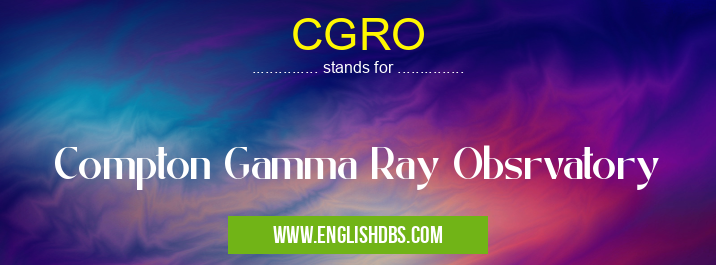What does CGRO mean in ASTRONOMY
The Compton Gamma Ray Observatory (CGRO) was an orbiting space observatory dedicated to the study of gamma rays. Developed jointly by NASA and the U.S. Department of Energy, CGRO operated from 1991-2000, observing high-energy phenomena across the universe in unprecedented detail and uncovering new information about the origins and evolution of cosmic rays. What began as a mission to explore this mysterious area of space has now resulted in a massive storehouse of data that continues to be examined today. This article will explain what CGRO is, how it works, and discuss its many discoveries

CGRO meaning in Astronomy in Academic & Science
CGRO mostly used in an acronym Astronomy in Category Academic & Science that means Compton Gamma Ray Obsrvatory
Shorthand: CGRO,
Full Form: Compton Gamma Ray Obsrvatory
For more information of "Compton Gamma Ray Obsrvatory", see the section below.
Essential Questions and Answers on Compton Gamma Ray Obsrvatory in "SCIENCE»ASTRO"
What is the CGRO?
The Compton Gamma Ray Observatory (CGRO) was a satellite observatory that was launched in April 1991 and operated until June 2000. It studied gamma rays and various other forms of energy being generated throughout the universe.
What kind of objects could the CGRO detect?
The Compton Gamma Ray Observatory was able to detect gamma ray bursts, supernova remnants, active galactic nuclei, neutron stars, pulsars, and other sources of high-energy emission from across the universe.
What type of technology did the CGRO use?
The CGRO employed four scientific instruments to measure x-ray and gamma ray photons. This included two imaging detectors that focused on low energy gamma rays, one detector that targeted medium energies, and one detector that captured high-energies above 500 keV.
How long did the CGRO operate for?
The CGRO mission ran from April 5th, 1991 until June 4th, 2000. During this time it conducted over 3 years of continuous observations across the entire sky.
What advances has the CGRO contributed to science?
The data collected by the Compton Gamma Ray Observatory has greatly advanced our understanding of cosmology and astrophysics. Specifically, it revealed intense cosmic gamma-ray sources as well as deepened our awareness of phenomena such as black holes and dark matter in our universe.
How did scientists interpret CGRO data?
By analyzing data collected from its detectors using mathematical models and computer simulations, scientists were able to understand a wide range of astronomical phenomenons such as stellar explosions or objects created by them like neutron stars or black holes.
Why was it important for scientific research?
By providing high resolution images along with spectral information about cosmic phenomena in greater detail than ever before possible with optical or radio telescopes, the data from the CGRO enabled further advances in astronomy by offering unprecedented insight into high-energy events occurring in our universe.
What happened to the observatory after it ceased operations?
After it stopped operations in June 2000 due to a depletion battery life among other reasons, it was deorbited and purposefully crashed into Earth’s atmosphere over an unpopulated area near Tahiti on June 4th 2001 where most pieces burned up upon reentry into Earth’s atmosphere while larger debris pieces fell into Indian Ocean
